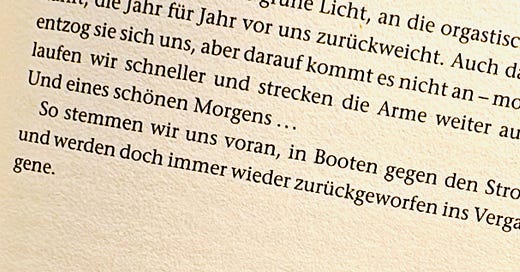Gatsby, White supremacy and the American dream
On the 100th anniversary of the publication of the Great Gatsby, it has never been more relevant.
“Civilisation is going to pieces … if we don’t look out the white race will be – will be utterly submerged. It’s all scientific stuff; it’s been proved.”
These are words of Tom Buchanan in the opening few pages of the greatest of the great American novels. Buchanan - the most grotesque in a cast packed with grotesque characters - is Daisy’s violent and cruel husband. In this unsolicited rant at dinner in front of bored socialites, he is bloviating racisms that he has borrowed from a popular science book that he’s just read: The Rise of the Colored Empires by a fictional scientist that F. Scott Fitzgerald concocted called Goddard. It’s a very thinly disguised reference to two of the most influential books of that American era. One is The Rising Tide of Color: The Threat Against White World-Supremacy, by Lothrop T. Stoddart. The other is The Passing of the Great Race by Madison Grant. All three books were edited by the same man, Maxwell Perkins.
I’ve written and radioed about Gatsby several times, including in my book (Control) and Radio 4 series (Bad Blood) about the history of eugenics. For me, Gatsby charts the distance between the American dream and its reality, which is more starkly exposed today than in decades. My guide in these waters is Sarah Churchwell, historian and arguably the greatest of Gatsby scholars (listen to her new podcast with David Olusoga). But I’m writing these words now sitting on a bench to the south of the Memorial to the Murdered Jews of Europe in Berlin. This is my view.

I spend a lot of time in my writing in Berlin, not just on the rise of rassenhygiene that led to the Holocaust, but the huge developments in evolutionary theory in the post-Darwinian years, by Ernst Häeckel, and particularly August Weissman, who planted the seeds of the Modern Synthesis – the fusing of Mendelian genetics with Darwinian Natural Selection – a revolution in biology and mathematics that the foundations of genetics and statistics rest upon.
This is the first time I’ve been here in twenty years though, and I’m thinking about Gatsby on its 100th birthday, and the stone it marks on the pathway to what I see in front of me.
Immigration, White supremacy and eugenics are subjects bubbling close to the surface in Gatsby. These were the obsessions of the Long Island aristocrats that F. Scott Fitzgerald is observing, with a personal connection to them. Join the dots:
Fitzgerald had met Mary Harriman Rumsey, eldest daughter of Mary Harriman and the railroad tycoon E.H. Harriman, at Old Westport, which was a significant model for the Long Island residence of Jay Gatsby and his cohort of careless people. In Fitzgerald’s notebooks, he makes references to attending her parties in the 1920s, as does his wife Zelda in a letter in 1930. Mary (junior) was nicknamed Eugenia by her Barnard College classmates, due to her fascination with the idea of scientific betterment for White Americans. She was taught by Charles Davenport, the principle architect of the American eugenics programme, and introduced him to her mother, millionaired and widowed. Along with John D. Rockefeller and Andrew Carnegie, Mary Harriman funded Davenport’s Eugenics Record Office (ERO) at Cold Spring Harbour, from its inception in 1910 to its demise just before the Second World War, when Davenport was ailing, and people were beginning to see what was happening in Germany.
Lothrop Stoddard was a member of the Committee on the Heredity of the Feeble Minded under Davenport at the ERO, just down the road from the lab that remains one of the great centres of genetics research to this day. Madison Grant, a rich bored Manhattan socialite wrote the introduction to Stoddart’s 1920 book, following the success of his 1916 book The Passing of the Great Race. It’s a mad screed, a treatise of pseudoscientific White superiority that asserted a hierarchy of the world’s peoples drawn from anthropological theories of the time. This model asserted, erroneously, that there were three types of humans: Caucasoid, Mongoloid and Negroid. Of the Caucasoids, Northern Europeans from Scandinavia, northern England and Scotland, and Germany were supreme. Its arguments are almost comically unhinged. He declares that according to measurements of busts of their heads, Leonardo da Vinci, Michelangelo and Dante were Nordic, and that tall blond Nordic men seeded the great cultures of Rome, Greece and Egypt before retiring back to their wooded northern fatherlands.
Hitler read The Passing of the Great Race whilst in prison in 1923 following his failed coup. This was when he wrote Mein Kampf, and was part of his radicalisation. Grant later claimed that Hitler referred to it as ‘his Bible’. After he took power in early 1933, it was the first foreign language book to be published under the Third Reich. Davenport and his deputy, a brutish enforcer called Harry Laughlin, spent time in Germany in the 1930s, funded by Rockefeller, to instruct Nazi scientists on the science and legal aspects of eugenics. These policies, drawn directly from US eugenics legislation written by Laughlin were the basis of some of the first laws the Third Reich passed, that formed the foundations of the genocides that would follow.
As a historian of this period, it is painfully hard not to see Gatsby echo in our present. Mega-wealthy, scientifically illiterate industrialist blowhards, obsessing over population growth, Great Replacement theory, immigration, who leverage their un-earned power to determine policy.
It mildly amuses me that Gatsby is sometimes regarded as a glamorous tale of flappers and champagne-swigging socialites. It’s a tragedy, a horror story, and a century after its publication, it’s a warning of the path that America is once again on. I bought a German copy of Gatsby today. Here is that iconic final line in this beautiful language.
So stemmen wir uns voran, in Booten Gegen den Strom, und warden doch immer wieder zurückgeworfen ins Vergangene.





Excellent essay, Adam! 👏
Because we do not teach accurate US history in our K-12 system, many people believe that the “America” that existed between 1945-1975 has always been there. No wonder they are shocked as things revert back to baseline.
"... Gatsby is sometimes regarded as a glamorous tale of flappers and champagne-swigging socialites. It’s a tragedy, a horror story, ..."
By chance more than anything, I read The Great Gatsby for the first time only a couple of months ago. I do not intend to read it again. I disliked the book greatly because all of the characters and their attitudes were so deeply unpleasant. It was, and remains, a mystery to me why the book has such a popular reputation, and is read widely in US schools.
I followed reading The Great Gatsby with The Big Sur by Jack Kerouac which I experienced as quite refreshing in contrast.
Good photograph, by the way. I have visited Berlin and the Jewish holocaust memorial on four occasions. My experience of Berlin is that it is an emotional roller-coaster of history.